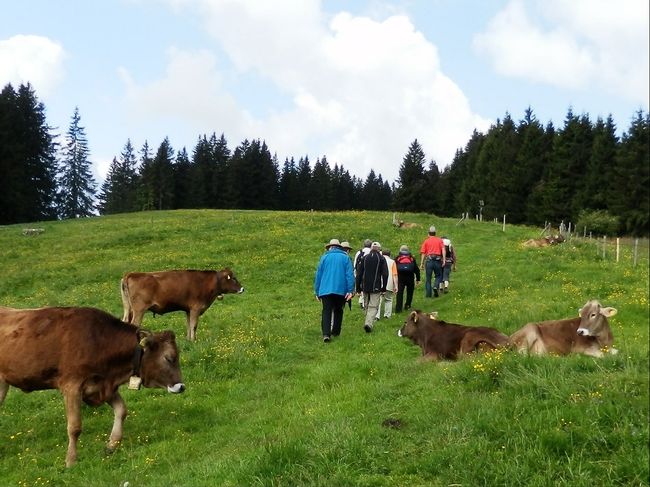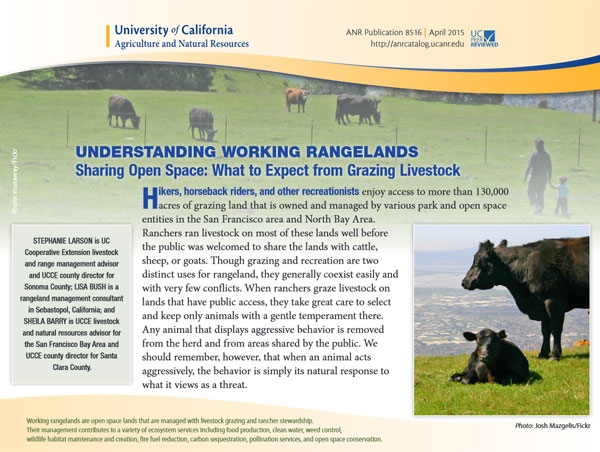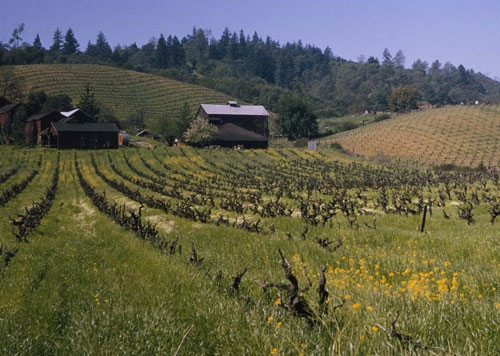Posts Tagged: Stephanie Larson
People and cattle can share open space
When a hiker on a San Francisco Bay Area parkland unknowingly walked between a cow and her calf, the mother came over, knocked the hiker down and stepped on him. In another incident, a woman walking her dogs off leash was chased by cows. She slipped and sprained an ankle.
Such incidents, though rare, prompted UC Agriculture and Natural Resources (UC ANR) experts to write guidelines for people who hike, cycle or ride horses in natural areas where grazing cattle are used to manage the land. The four-page publication, Sharing Open Space: What to Expect from Grazing Livestock, is available for free download from the UC ANR online catalog.
“Areas that were traditionally rangelands, especially in urban counties, are more and more often becoming parklands,” said Stephanie Larson, UC ANR Cooperative Extension livestock advisor in Sonoma County and lead author of the publication. “State parks generally remove grazing, but we didn't want to see that at regional and county parks.”
Cattle grazing can provide important services to these working landscapes, like managing the vegetation, reducing fire hazards, increasing water capture, and promoting the diversity of plant. With education, Larson believes, people who hike, bike and horseback ride can coexist peacefully with the cattle.
Cattle may seem intimidating because of their size, but they are vulnerable to attack by coyotes and other predators. As prey animals, cows naturally experience and express fear and protective behavior, especially when unfamiliar people and animals are near and to protect their young.
Cattle can feel threatened by dogs, which they will perceive as predators. The guidelines recommend keeping dogs close and under complete control at all times. Just like people, dogs should never get between a cow and her calf.
The guidelines detail typical cattle posture when relaxed and when agitated, their response to intrusions into their personal space (or “flight zone”), and reactions to loud noises.
“Unless you need to move cattle out of your way, such as move them off a narrow trail, it's best to give them plenty of space and avoid their flight zone altogether,” the guidelines advise.
Injured cattle should be reported and left alone. The guidelines suggest people never approach a cow from behind, make quick movements or flap their arms, or try to “rescue” calves that seem to be separated from their mothers.
“The mother may be off drinking or eating, and will return to the baby,” the authors write. “She may even be watching you.”
Co-authors of the guidelines with Larson are Sheila Barry, UC ANR livestock and natural resources advisor in the Bay Area, and rangeland management consultant Lisa Bush.
An initiative to maintain and enhance sustainable natural ecosystems is part of UC Agriculture and Natural Resources Strategic Vision 2025.
UC ANR publication helps hikers co-exist with cows
Hikers, cyclists and runners can learn to enjoy nature alongside grazing cattle with information from a new UC Agriculture and Natural Resources publication, reported Andrew McGall in the Contra Costa Times.
Sharing Open Space: What to Expect from Grazing Livestock, written by Stephanie Larson, UC ANR Cooperative Extension livestock advisor, is available free in ANR Catalog.
The publication explains how to read the behavior patterns of cows with calves, heifers, steers and bulls. For example, when approaching a cow on the trail, it's best to stay in it's "flight zone" to encourage it to move out of the way.
The guideline says dogs accompanying hikers must be kept under control.
"Cattle see dogs as predators," the brochure warns. "This is especially true for mother cows, who naturally become aggressive when trying to protect their young."
The story was also covered by the Sacramento Bee on May 27:
Moooving along: How to handle a cow on the trail
Sam McManis, Sacramento Bee, May 27, 2015
Waving one's arms, clapping and yelling? Not recommended, according to a new downloadable brochure, “Sharing Open Space: What to Expect From Grazing Livestock,” published by University of California Division of Agriculture and Natural Resources. “(Cattle) don't necessarily react how you expect them to, because of that issue with the flight zone,” said Sheila Barry, UC ANR Cooperative Extension advisor. “So, you think, ‘Hey, I'm getting really close, why aren't you moving, cow?' Most will move off, eventually. But there's part of it that's just not predictable.”
UCCE teaching the next generation of farmers
Students accepted into a new farming and ranching education program being offered by UC Cooperative Extension in Sonoma County and other institutions will have their first of nine monthly meetings March 30, wrote Michael Shufro in the Santa Rosa Press Democrat.
“We recognize that the current population of farmers is aging, and that we need to get our younger farmers prepared and ranching,” said Stephanie Larson, UC Cooperative Extension advisor in Sonoma County and director of the new training program. “We’re really hoping to not only get more farmers and ranchers trained, but to increase food access and food production in Sonoma County, and also to teach more people about where their food comes from.”
Students in the program will split their time between classwork with ag teachers, field work with local farmers and business plan development with small business experts. The program will expand to include the broader farming community, connecting students with restaurants and grocers that buy local produce and the slew of farmers’ markets around the county.
“Programs like this strengthen the parts we already have and bring farmers together,” Larson said. “We used to work mainly in silos, but we’ve been breaking those silos down, and finding it works much better together than separately.”
Another blessing for Napa
Paul Franson, Napa Valley Register
On top of wine, food, arts and culture that some large cities might envy, Napa Valley has an invaluable, little-recognized asset: an uncommonly cooperative and educated wine industry.
Artisan cheesemaking coming of age in California
The development of an artisan cheesemaking industry in Sonoma and Marin counties is enhancing the ambience of agriculture in the picturesque rural community, according to Stephanie Larson, the director of UC Cooperative Extension in Sonoma County.
She made the comment in an article that ran over the weekend in the Santa Rosa Press-Democrat about dairies adding value to their product by creating gourmet cheeses. Much of the data shared in the story came from a report developed by UCCE community development advisor Ellie Rilla, Coming of Age: The Status of North Bay Artisan Cheesemaking, which was released in January.
Marin and Sonoma counties have 22 commercial cheese plants which produce 8 million pounds of artisan cheese each year, with a retail value of $119 million, according to the study.
"It's the largest concentration in California," the story quoted Rilla. She said one-third of the businesses have been making cheese for three years or less.
Though growing, the North Bay's artisan cheese business is tiny compared to California's commodity cheese industry, which produces 2 billion pounds of cheese annually, half of it mozzarella.
Many artisan cheesemakers turn to organic production and special blends to set themselves apart. For example, producer Craig Romanni plans to be the area's first buffalo mozzarella maker and the Bohemian Creamery near Sebastopol makes nine different cheeses, including a sheep/cow blend infused with cacao nibs, the story said.
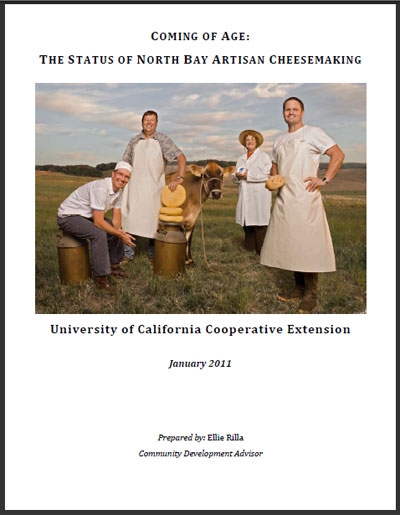
The UCCE report on artisan North Bay cheesemaking.
Sonoma County opens vacant land to ag production
The Sonoma County Board of Supervisors voted yesterday to open county land — including parts of parks, open space parcels and vacant lots in residential areas — to community gardeners and small commercial farmers, according to the Santa Rosa Press Democrat.
The initiative is designed to make land available for agricultural production in an area where high land values make it nearly impossible to farm.
UC Cooperative Extension in Sonoma County will conduct an inventory to identify suitable land for the project. The researchers will consider property owned by the county water agency and land controlled by the general services department, the article said. The study and plans for application and training will be be completed in June.
“We've got this land. How do we go about giving people access to it?” the article quoted Stephanie Larson, director of UCCE in Sonoma County.
The program was praised by health advocates — who believe more local farming and gardening could ease the county's obesity rate — and small-scale farmers.
“There are a lot of young farmers who want to get into business,” Santa Rosa small farmer Wayne James told reporter Brett Wilkison. “(The county) should really be doing more of this.”
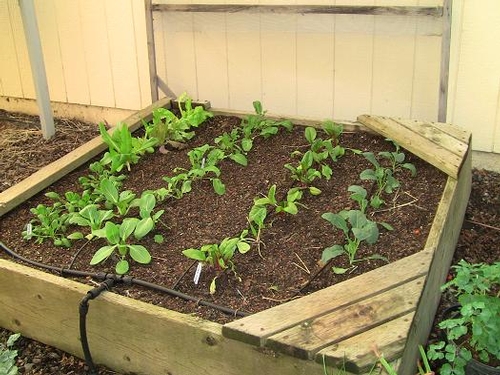
Small farms and gardens to spring up in Sonoma County.


